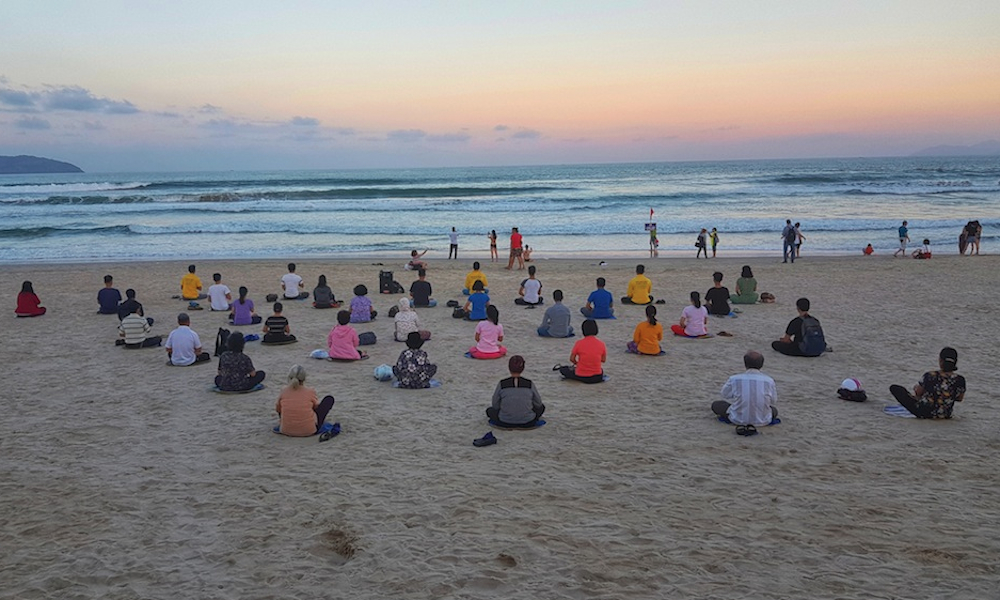
You have either made the decision or are thinking about heading to Vietnam for two weeks. But taking out your smartphone and searching “What to do in Vietnam” can be a bit daunting. There are endless places and things to see and it is hard to construct a compact itinerary based on what’s online. For those interested in doing a two-week trip in Vietnam, the itinerary below could be your bible. Lainey Quinn, aka Little Miss Sunray, is in the middle of a solo travel adventure through Vietnam and has written this guide based on her own experiences.
Day 1: Ho Chi Minh City
Fly into Ho Chi Minh City (the locals still call it Saigon), get your Vietnamese visa, and get ready to start your two-week adventure in one of the world’s most incredible cities. Rise and shine early on the first morning and get a big breakfast and a strong cup of Vietnamese coffee into you. Head off on foot and tick the following places off your bucket list:
- War Remnant Museum
- Reunification Palace
- Ngoc Hoang Temple
- Notre-Dame Basilica
For more tips on what to do in Ho Chi Minh City, check out Lainey’s blog here.
If you’re feeling tired or jetlagged (Vietnam is seven hours ahead of Ireland), try to stay up until a reasonable hour and get an early night. Hopefully you will wake feeling well rested and ready for another full day of exploring.
Day 2: Ho Chi Minh City
I would highly recommend going to the Cu Chi Tunnels on Day 2. It will expand your knowledge of the country’s tragic but fascinating war history and you get to crawl through an underground war bunker tunnel. However, those who have a fear of the dark or small spaces should do an alternative excursion for the day (such as rooting through the Ben Thanh Market!).
Day 3: Ho Chi Minh City/Da Lat

By this stage, you will be an expert on Vietnamese history and you and your camera need a few hours of relaxation. Take a leisurely stroll to one of the public parks scattered throughout the city, sip on a cold drink and people-watch. There are many Zumba and exercise sessions on in the parks throughout the day, so join in and stretch those legs! If there’s time, you could also go for a walk along the Saigon River and feast on piping hot phở by the water.
At night, grab a taxi back to your hotel, get your bags and head for the bus station. Tonight, you will travel on one of the comfiest sleeper buses in Southeast Asia. Buy a bus ticket (250,000vnd/€9.37) with Futa Buslines (272 Đường Đề Thám, Phường Phạm Ngũ Lão, Quận 1, Hồ Chí Minh City) the day before and turn up at the bus stop 15 minutes before departure time. Six hours after leaving Ho Chi Minh City, you’ll arrive in Da Lat and a free Futa shuttle bus will take you to your hotel.
Tip: If you get the late sleeper bus (9.00pm), contact the hotel in Da Lat before you leave Ho Chi Minh City and tell them the time you plan on arriving. Because you will arrive at around 3.00am, the hotel will offer to either check you in early for an extra fee or prepare a private resting space.
Day 4: Da Lat
You will instantly notice a big difference in Da Lat compared to Ho Chi Minh City – the air is clean. Take this as an opportunity to clean out your lungs from all the smog you inhaled over the past few days by going on a mountain walk. Immerse yourself in the tranquil silence and fresh air while taking in the breath-taking views of endless jungle. In the evening, head into Da Lat City and taste some delicious Vietnamese cuisine. You’ll know how good a local restaurant is by the number of locals eating there.
Day 5: Da Lat/Da Nang
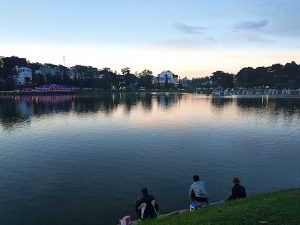
On your second day in Da Lat, book a Grab taxi to bring you to Hằng Nga Crazy House. Spend an hour marvelling at the fairy-tale architecture while you explore this hotel (yes, you can stay here for €50 per night). Next, take another Grab to Lam Vien Square and chill by Xuan Huong Lake for a while. But don’t get too comfortable, because it’s nearly time to head to the airport! Take a taxi to the airport and fly 1.5 hours to Da Nang (a taxi from Da Lat to the airport costs 170,000vnd/€6.38).
Day 6: Da Nang
Da Nang is not only perfect for those who want a quite break from the hustle and bustle of cities. It’s here that you get to relax on a white, sandy (clean) beach, taste endless amounts of authentic and mixed cuisines, and see the most spectacular sunsets and views in the whole of Vietnam. Stay close to the My Khe Beach and you’ll be close to everything! Da Nang is also amazing for tasty cocktails that aren’t overpriced. The best places for cocktails are Oasis (tapas bar) and Crazy Cat (lots of live music).
On your first day in this beautiful city (which is currently my new home), I recommend renting a motorbike early morning from https://motorvina.com. Then drive about 30 minutes along the My Khe beach to the humungous Lady Buddha statue and drive around Monkey Mountain. Next, drive to Marble Mountain, a pagoda-laden cluster of marble and limestone hills that have caves the size of mansions. Leave yourself 1.5 hours to get from the foot of the hills to the top for sunset!
Day 7: Da Nang
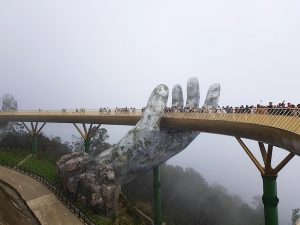
Get ready to have the strangest, most breath-taking and extraordinary experience high up in the clouds. Today you will tackle the Golden Hands Bridge. There’s no public transport to take you to the bridge (also called SunWorld Fantasy Park), so the only way to get there is by driving your rental bike or by taxi, which would cost 250,000vnd one-way. If you’re driving, it should only take 45 minutes from Da Nang if you follow Google Maps directions to “Ba Na Hills cable car carpark station”. Check out Lainey’s blog for tips for visiting the Golden Hands Bridge.
Get back to Da Nang in the evening and if it’s a Saturday or Sunday, head into the city for the Dragon Bridge fire and water show at 9.00pm. The best spot from which to watch the 15-minute display is the rooftop bar on the 13th floor of Danang Riverside Hotel. No need to dress fancy for the event or venue!
Day 8: Da Nang/Hue
A must-do while in Da Nang is the Hai Van Pass on a motorbike. Stock up on supplies such as water and food, leave the hotel at about 10.00am and ride the six-hour coastal route to Hue, through the 21km Hai Van Mountain Pass. If you hired the bike from Motorvina, they will let you drop it off in Hue (before 5.30pm) and they will transport a bag for free to your Hue hotel. Your bum will need a rest after the drive, so chill out for the evening and take a stroll around the old imperial city of Hue with its idyllic Perfume River, colourful temples and old-style Vietnamese architecture.
Day 9: Hue/Hanoi
Take a quick flight from Hue to Hanoi and get ready to tackle another big Vietnamese city, with a lot of pollution. Tourists are advised to wear masks here, as the air is quite dirty, and smog settles thickly over the whole city. But to enjoy Vietnam to its fullest, tourists need to look past the filth and appreciate what’s behind the smoke.
I recommend staying in the charming Old Quarter in Hanoi where it’s a bit cleaner and close to many sights and attractions. During your stay in Hanoi, check out the Women’s Museum, Trấn Quốc Pagoda, and Bach Ma Temple (the oldest temple in the city). In the evening, take a stroll along the serene Hoan Kiem Lake and watch the world go by while you sip on a local beer (Huda, Larue or Saigon are the best).
Day 10: Hanoi
Head off on a full-day biking tour of Hanoi and get your fill of history, architecture and stories that only a local tour guide would be able to tell you.
Day 11: Hanoi/ Cát Bà Island

The next day, make your way to Hanoi’s ferry port and pop over to Cát Bà Island. There are plenty of cheap bus/ferry companies – just ask your hotel and they will advise on the options.
Stay at Cát Bà Mountain View Hotel (€8 per night) in the cute traditional huts (private rooms) and enjoy an impressive free breakfast. If you have the energy, rent a motorbike cheaply in the city (it will be more expensive to rent from the hotel) and explore the island’s secret beaches.
Day 12: Cát Bà Island
Dedicate a full day to hiking around the National Park and keep an eye out for the 32 types of mammals that live there. You might even encounter one of the world’s 65 remaining golden-headed langur, which is also one of the world’s most endangered primates. To reach the park headquarters at Trung Trang, hop on the green QH public bus from the docks at Cát Bà Town (25,000vnd/€0.94), hire a taxi (around 80,000vnd/€3 one-way), or take a rental motorbike.
Day 13: Hạ Long Bay Cruise
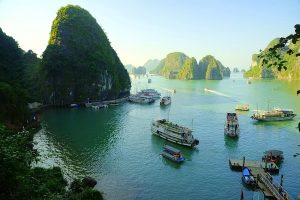
Start your Hạ Long Bay cruise today and get ready to enjoy swimming in crystal clear waters, canoeing through huge water caves and hiking with monkeys. Again, ask your hotel to recommend what company to book your cruise ticket with – many tour operators offer different prices with varied inclusions.
Day 14: Cát Bà Island
Head back to Cát Bà for a final night and some last-minute exploration before you back-track to Hanoi for your flight home the following day. Explore the Hospital Cave and then head to Canon Fort for a magical sunset to finish off your two-week holiday in Vietnam.
Day 15: Cat Ba Island/Hanoi
Take in the final views of Hạ Long Bay before you make your way back to Hanoi today.
Day 16: Hanoi/Home
Travel to Hanoi and catch a flight back to Ireland or to your next exciting destination!
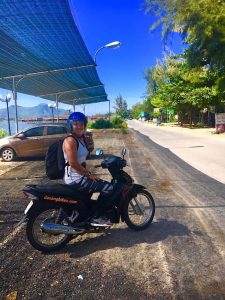
10 Things to Know About Vietnam
Bargain, bargain, bargain – Everything in Vietnam, apart from food in a restaurant, can be bargained down at least 50%. Don’t be afraid to haggle!
Check the weather – The weather changes quickly in Vietnam (like in Ireland), so research the expected temperatures for the areas to which you will travel. For cold and rainy seasons, pack a rain jacket and shoes that cover your ankles.
Eat where locals eat – Street food hygiene doesn’t exist in Vietnam but if you eat where other locals are, you have less chance of getting food poisoning.
Don’t drink tap water – Water pollution is common in Vietnam. To avoid contracting any diseases or bacteria in water, stick to bottled water. Hotels and hostels will charge less for two-litre bottles of water compared to local shops (don’t pay more than 15,000vnd/€0.45).
Watch your belongings – Hanoi and Ho Chi Minh City have lots of pickpockets, as do the smaller, touristy towns such as Hoi An. Don’t cross the road holding your phone in front of your face and don’t carry wallets or purses in your hand (both can be quickly snatched out of your hand by a passing motorcyclist or pickpocket).
Bring cold hard cash – Many eateries, markets and local restaurants won’t take credit cards – and if they do, you’ll be charged an extra 30%. Bring as much cash as you can to Vietnam to avoid paying the extra fees.
Changing money – If you happen to bring Euros in cash to Vietnam and need to change it to Vietnamese Dong, go to a jewellery shop at a market or in a hotel. Both will give you a better exchange rate than a bank or Western Union. There are a good few jewellers near the Bến Thành Market in Ho Chi Minh City and they’ll give you the best currency rate in the city.
Renting a motorbike – If you’re hiring a motorbike, choose a Honda Wave, Honda Blade or Yamaha Sirius. These are the three main bikes that locals use and, if you have any problems on the road, almost every Vietnamese is a mechanic, very familiar with those bikes and will be able to help you.
Riding motorbikes in Vietnam – If you’re a thrill seeker and have rented a motorbike to travel around on, be careful. The traffic is chaotic in the bigger cities (Hanoi and Ho Chi Minh City) so stick to Grab taxi bikes there. It’s safe to travel on a motorbike anywhere other than those cities but wear the appropriate clothing, shoe-wear and always wear a helmet.
Google Translate – Not many Vietnamese people speak English, but that shouldn’t deter you from having a conversation with them. Get used to asking questions using Google Translate and not only will that make life easier for when you’re buying something or asking a general enquiry, you might even make a Vietnamese friend for life.




